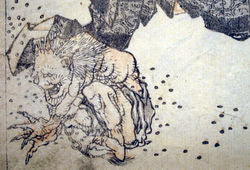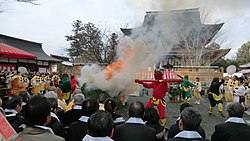
Setsubun
Share
Setsubun (節分) is a Japanese celebration held the day before the start of a new season of the year. The name literally means "separation of seasons", but in general the term refers to the spring setsubun, properly called risshun (立春), celebrated annually on February 3.
In association with Chinese New Year, spring setsubun can be considered a type of New Year's Eve, and is also accompanied by a special ritual to cast out all the evil of the previous year and ward off demons in the new year. This ritual is known as mamemaki, literally scattering beans.
Mamemaki

The mamemaki is usually performed by the toshiotoko of the household, for example, the man who was born in the year of the corresponding animal of the Chinese zodiac, or the head man of the household.
A particular type of soybeans called irimame are thrown at the door or at a family member wearing an oni mask, while the throwers say "Oni wa soto! Fuku wa uchi!'' (鬼は外福は内). The literal meaning of the words is "Away with the oni, let good luck come!"
The seeds are symbolically thrown to purify the house by casting out evil spirits and driving away bad luck and ill health with them. Then, as part of bringing good luck, it is customary to eat the soybeans, one for each year of life, and in some places, one for each year of life plus one for the coming year by way of bringing good luck for that year.
Setsubun Other practices

At Buddhist temples and Shinto shrines throughout the country, there are setsubun celebrations. Priests and special guests throw roasted soybeans (some wrapped in gold or silver leaf), small envelopes with money, sweets and other gifts to the people.
At some large chapels, even celebrities and sumo wrestlers are invited, and some of these events are broadcast on national television. Nowadays, it is customary to eat uncut ehō-maki rolls on the night of setsubun while looking in the direction of the coming year's good luck, determined by that year's zodiac symbol.
The cards are distributed and occasionally accompanied with an ehō-maki during the month of February. Families also place small decorations with sardine heads and holly branches at the entrances to their homes so that evil spirits will not enter.
Setsubun Regional variations
Although the practice of eating maki-zushi at setsubun is historically associated with the Kansai area of Japan, the practice has become popular nationwide largely because of restaurant marketing efforts.
In the Tohoku region, the head of the family carries an irimame in his hand, prays in the family chapel, and then throws the sanctified seeds out the door.
Today peanuts are sometimes used instead of soybeans.
There are some variations of the famous Oni wa soto! Fuku wa uchi. In the Fukushima region, the chant is shortened to "鬼は外! 福は内!" (Oni wa soto! Fuku wa uchi!). In Aizuwakamatsu city, people say "鬼の目玉ぶっつぶせっ!" (Oni no medama buttsubuse!).








